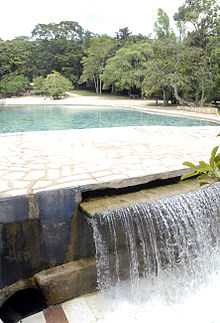Brasília National Park
| Brasília National Park | |
|---|---|
|
IUCN category II (national park) | |
 Brasília National Park | |
 | |
| Location | Near Brasília, Federal District, Brazil |
| Coordinates | 15°44′17″S 47°55′36″W / 15.738056°S 47.926667°WCoordinates: 15°44′17″S 47°55′36″W / 15.738056°S 47.926667°W |
| Area | 423.83 km ² |
| Established | November 29, 1961 |
The Brasília National Park (Parque Nacional de Brasília) is a national park located 10 kilometres (6.2 mi) from the centre of Brasília, in the Federal District, in the center west of Brazil. The park covers an area of 423.83 square kilometres (163.64 sq mi), with territory spanning the suburbs of the Brazilian capital city of Brasilia, Brazlândia and Sobradinho and the municipality of Padre Bernardo. It is currently administered by the Chico Mendes Institute for Biodiversity Conservation (ICMBio). It is the largest park in the world which is situated in an urbanized area.[1]
History
The creation of the park, on November 29, 1961, was under Federal Decree of Brazil on 29 November 1961 covering an area of 28,000 hectares (69,000 acres) (initially 30,000 hectares (74,000 acres) was proposed) extending over an elevation range of 700–1,300 metres (2,300–4,300 ft). It is under IUCN Category II.[2] It is directly related to the development of Brasilia. According to the Ministry of Agriculture, the park was protected to provide forested area around the national capital of Brazil. In 1994, seventy percent of the park burned.[3]
Geography

The park is in the north east of the Federal district in the northeastern region of Brazil. Its boundaries have been fixed and also fenced.[2] The park is divided into Intangible, Primitive, Extensive, Intensive, Special and Recuperation zones from the development perspective.[citation needed]
The terrain is an undulating plateau with geological formations of quartzites and limestones. It has many caves and several springs. The average annual rainfall reported is 1675 mm. Apart from the springs, the source of water supply to the park is also through a reservoir.[2] The most prominent features of the park are the pools formed from water wells. Several creeks flow through the park, including the Bananal, Torto, and Santa Maria Creeks. Because of the large number of springs, its nickname is Agua Mineral (mineral water); the water is reported to have healing properties.[4] There are many well laid out trekking trails through the park.[5]
Climate
The climate of the region, according to the Köppen classification, is "tropical savanna". The rainy season begins in October and ends in April, representing 84% of the annual total. The wettest quarter is from November to January, and December is the month with the highest rainfall of the year. The dry season is from May to September, and in the driest quarter is June, July, and August, when precipitation represents only 2% of the annual total. In terms of total annual average rainfall, Distrito Federal varies between 1,200–1,700 millimetres (47–67 in).[4] The park itself has an average annual rainfall incidence of 1675 mm. Average annual temperature reported is 20.6 degrees celsius. Eastern winds are dominant in the park.[2]
Wildlife
- Flora

Cerrado/upland savanna trees, the dominant vegetation in the central regions of Brazil, forms the core area of this park. However, the vegetation around the springs and streams are of Campo Cerrado type, which consists of gallery forests. These areas fall under the biosphere reserve declared by UNESCO. The plant species reported from the park are Buriti Palm and many species of the Velloziaceae (a family of monocotyledonous flowering plants.[2] The park has established a forest tree nursery and is also running a centre for environmental education.[5]
- Fauna
The faunal species reported from the park are the following:[2] Maned wolf (Chrysocyon brachyurus), pampas deer (Ozotoceros bezoarticus), giant anteater (Myrmecophaga tridactyla), bush dog (Speothos venaticus), giant otter (Pteronura brasiliensis), giant armadillo (Priodontes giganteus), black howler monkey (Alouatta caraya), forest rabbit (Sylvilagus brasiliensis), Juscelinomys candangus, cavy (Galea spixii), Calhartes burrovianus urubutinga, Mussurana (Portuguese muçurana) and tegu (Tupinambis teguixin).[2] Also reported are Black-tufted marmoset (Callithrix penicillata), capybara, jaguar, wild pig and puma.[5][6]
Avifauna include greater rhea (Rhea americana), red-legged seriema (Cariama cristata), osprey (Pandion haliaetus), king vulture (Sarcoramphus papa), crowned eagle (Harpyaliaetus coronatus), seed finches, Oryzoborus crassirostris, O. angloensis, spotted tinamou (Nothura maculosa), Lesser Yellow-headed Vulture (Cathartes burrovianus), curl-crested jay (Cyanocorax cristatellus), fer-de-lance (Bothrops jararaca), burrowing owl (Athene cunicularia), and toco toucan (Ramphastos toco).[2]
See also
References
- ↑ Forest, Christopher (1 September 2011). Brazil. ABDO. pp. 7–. ISBN 978-1-61787-620-2. Retrieved 26 January 2013.
- ↑ 2.0 2.1 2.2 2.3 2.4 2.5 2.6 2.7 Iucn Directory of Neotropical Protected Areas. IUCN. 1982. pp. 78–. ISBN 978-0-907567-62-2. Retrieved 3 January 2013.
- ↑ FAO Meeting on Public Policies Affecting Forest Fires: 28-30 October 1998 : Proceedings. Rome: Food & Agriculture Org. 1999. pp. 92–. ISBN 978-92-5-104289-2. Retrieved 26 January 2013.
- ↑ 4.0 4.1 Fodor's (15 July 2008). Fodor's Brazil, 5th Edition. Random House Digital, Inc. pp. 351–. ISBN 978-1-4000-1966-3. Retrieved 26 January 2013.
- ↑ 5.0 5.1 5.2 "Brasilia National Park". Planetwildlife.com. Retrieved 28 January 2013.
- ↑ "Souuheastern Brazil November – December 2007" (pdf). BirdingRio.com. Retrieved 29 January 2013.
